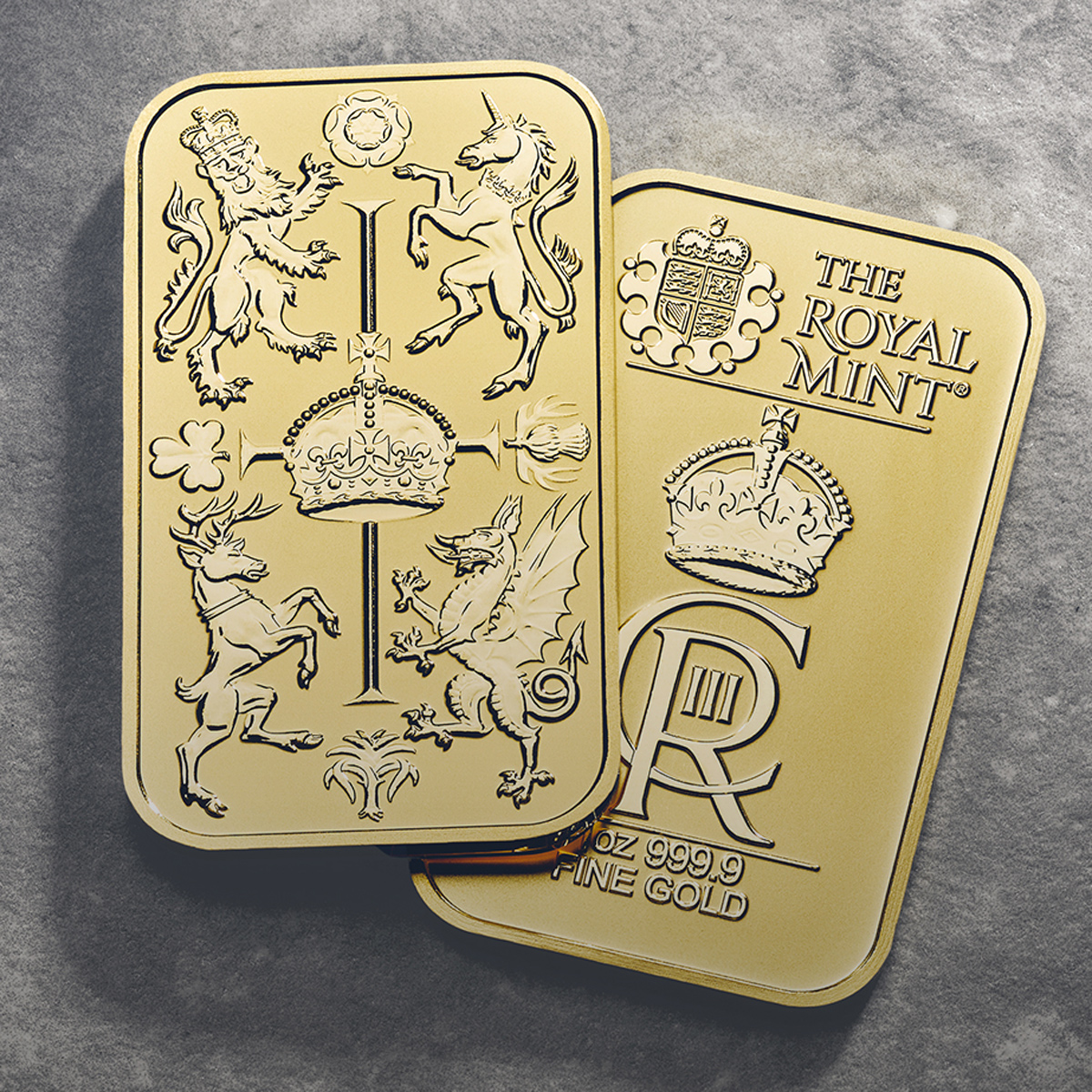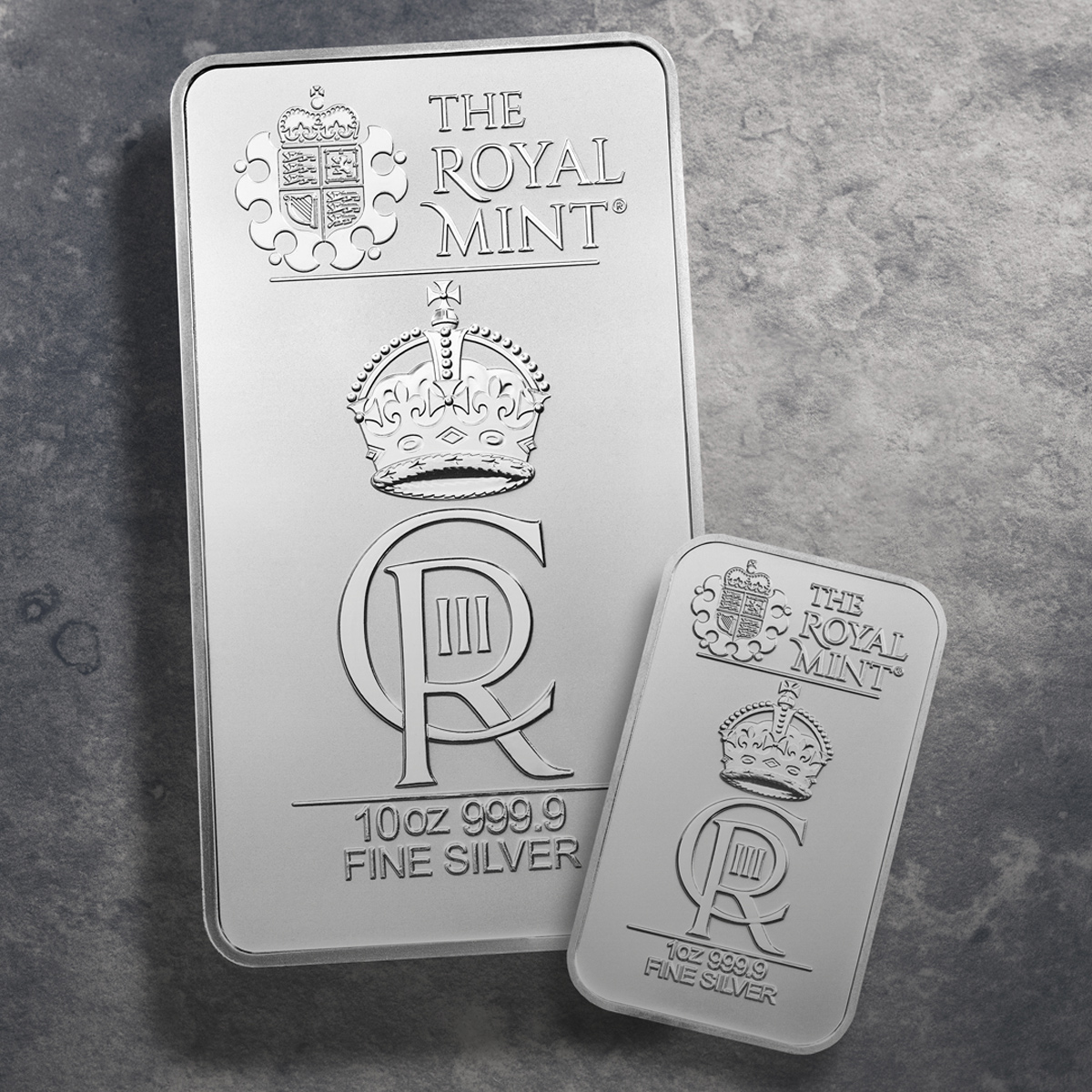The Royal Mint marks the accession of King Charles III with the Royal Celebration, heraldic-themed gold and silver bars
Launched today, the Royal Mint’s latest bullion bar dives deep into the United Kingdom’s heraldic traditions with a design quintessentially British, issued to mark the occasion of King Charles II’s ascension to the throne. Featuring the four national animals of the major components of the Union, they are depicted surrounding the Royal Crown. The theme continues on the obverse face, centred around the Royal Cypher of King Charles III.
There are three formats in the range at launch, starting with a one-ounce silver variant having a 70,000 mintage, complimented by 6,000 ten-ounce bars. The sole gold offering is a one-ounce bar with a 5,000 mintage. The two one-ounce versions are presented in secure blisterpacks. An attractive release from a respected producer. Available to order now, it will commence shipping in a weeks time.
PRESS RELEASE: The Royal Mint, the UK’s home of precious metals, has today unveiled a new minted bullion bar range, which celebrates and marks the anniversary of His Majesty King Charles III’s accession to the British throne. It’s the first bullion bar to represent His Majesty King Charles III. Each bar features His Majesty King Charles’s royal cypher and an intricate reverse design depicting the four heraldic beasts of the United Kingdom.
The Royal Cypher design comprises an interlocking C and R with ‘III’ enclosed within the text. Each letter in the cypher represents his Majesty’s reign: C for Charles, R for Rex – which means ‘King’ in Latin, and the ‘111’ represents the third Carolean era. The cypher also pays tribute to George V1, King Charles III’s grandfather, with His Majesty’s monogram featuring the Tudor crown, also worn by his grandfather.
The other design, created by Thomas T Docherty, is an intricate, heraldic design featuring symbols and flowers of the United Kingdom, surrounded by the Tudor crown in the centre. The crowned Lion of England, The Unicorn of Scotland, the Dragon of Wales and the Elk of Northern Ireland all feature on the bar
A Lion has represented England since at least the reign of Richard 1, who many know by the name ‘Richard the Lionheart.’ At the time, three lions represented England in battle on the Royal banner of arms, and they now represent England on one of the biggest sporting stages in international football. As such, the Lion is synonymous with England and the crowned Lion in this design represents His Majesty King Charles 111.
A Dragon has represented Wales since the fourth century, and the victories and myths of Welsh Kings against the Roman forces. Since then, it has become a key part of British folklore and the legends of King Arthur. A leek accompanies the Dragon on the bullion bar; a popular symbol of Wales that dates back to the sixth century and St David, the patron saint of Wales, who ordered his men to strap leeks to their armour to distinguish themselves from the enemy in battle.
A Unicorn has been a prominent feature of the Scottish Coat of Arms since 1603, when James 1 united England and Scotland, though it had long been a symbol of Scotland. It is said only a King can command a unicorn, therefore the crown placed around the Unicorn’s neck in Thomas T Docherty’s design represents King Charles 111 as monarch. The unicorn is partnered with a Scottish thistle, which has been a part of Scottish heraldry since the late thirteenth century. It has come to represent the Order of the Thistle, a chivalric order of Scotland comprising the sovereign, sixteen knights and ladies appointed by the sovereign and further knights – usually members of the Royal Family. The honour is awarded to those who have made a remarkable contribution to Scotland and the United Kingdom.
The elk is a prominent feature on the Coat of Arms of Northern Ireland, which highlights a union between the islands of Britain and Northern Ireland. The elk is paired with an Irish clover. The shamrock has represented Ireland on the Royal Coat of Arms of the United Kingdom since the 1800 Acts of Union and has become a popular symbol of Ireland throughout the world.
| SPECIFICATION | |||||
| DENOMINATION | COMPOSITION | DIMENSIONS | FINISH | MINTAGE | |
| Undenominated | 31.1 g of 0.9999 silver | 28.98 mm x 49.96 mm | Bullion | 70,000 | |
| Undenominated | 311.0 g of 0.9999 silver | 90.02 mm x 51.92 mm | Bullion | 6,000 | |
| Undenominated | 31.1 g of 0.9999 gold | 49.96 mm x 28.98 mm | Bullion | 5,000 | |








Leave A Comment